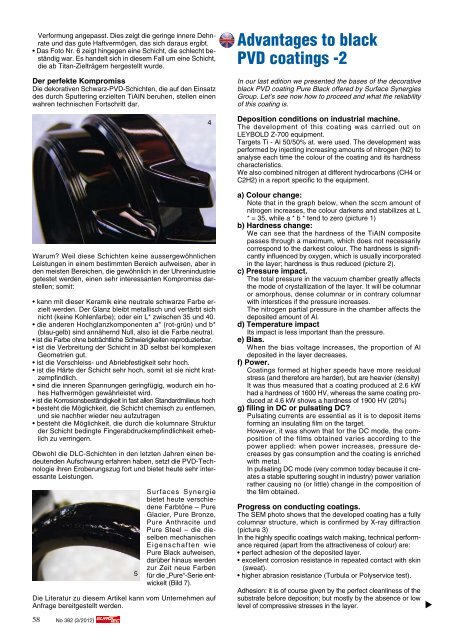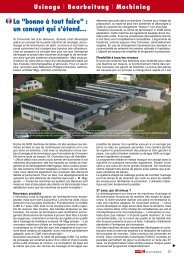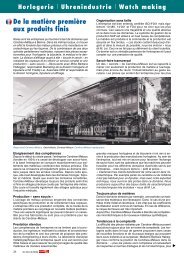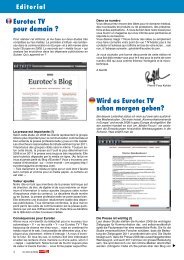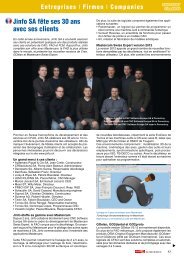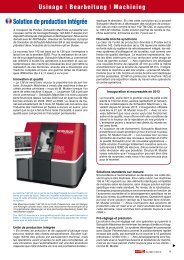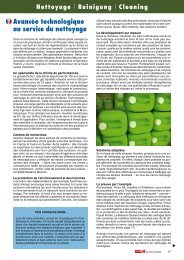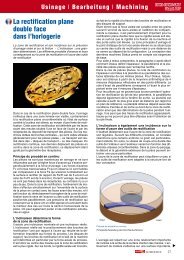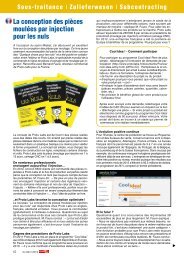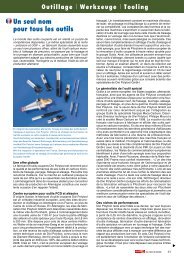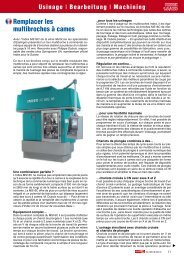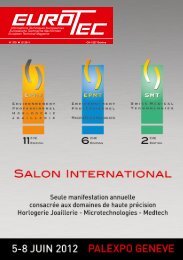EUROTEC N 382 (3/2012 )
EUROTEC N 382 (3/2012 )
EUROTEC N 382 (3/2012 )
You also want an ePaper? Increase the reach of your titles
YUMPU automatically turns print PDFs into web optimized ePapers that Google loves.
Verformung angepasst. dies zeigt die geringe innere dehnrate<br />
und das gute haftvermögen, das sich daraus ergibt.<br />
• Das Foto Nr. 6 zeigt hingegen eine Schicht, die schlecht beständig<br />
war. es handelt sich in diesem Fall um eine schicht,<br />
die ab titan-Zielträgern hergestellt wurde.<br />
Der perfekte Kompromiss<br />
die dekorativen schwarz-PVd-schichten, die auf den einsatz<br />
des durch sputtering erzielten tiain beruhen, stellen einen<br />
wahren technischen Fortschritt dar.<br />
Warum? Weil diese schichten keine aussergewöhnlichen<br />
leistungen in einem bestimmten Bereich aufweisen, aber in<br />
den meisten Bereichen, die gewöhnlich in der uhrenindustrie<br />
getestet werden, einen sehr interessanten Kompromiss darstellen;<br />
somit:<br />
• kann mit dieser Keramik eine neutrale schwarze Farbe erzielt<br />
werden. der glanz bleibt metallisch und verfärbt sich<br />
nicht (keine Kohlenfarbe); oder ein l* zwischen 35 und 40.<br />
• die anderen Hochglanzkomponenten a* (rot-grün) und b*<br />
(blau-gelb) sind annähernd null, also ist die Farbe neutral.<br />
• ist die Farbe ohne beträchtliche Schwierigkeiten reproduzierbar.<br />
• ist die Verbreitung der Schicht in 3D selbst bei komplexen<br />
geometrien gut.<br />
• ist die Verschleiss- und Abriebfestigkeit sehr hoch.<br />
• ist die Härte der Schicht sehr hoch, somit ist sie nicht kratzempfindlich.<br />
• sind die inneren Spannungen geringfügig, wodurch ein hohes<br />
haftvermögen gewährleistet wird.<br />
• ist die Korrosionsbeständigkeit in fast allen Standardmilieus hoch<br />
• besteht die Möglichkeit, die Schicht chemisch zu entfernen,<br />
und sie nachher wieder neu aufzutragen<br />
• besteht die Möglichkeit, die durch die kolumnare Struktur<br />
der schicht bedingte Fingerabdruckempfindlichkeit erheblich<br />
zu verringern.<br />
obwohl die dlc-schichten in den letzten Jahren einen bedeutenden<br />
aufschwung erfahren haben, setzt die PVd-technologie<br />
ihren eroberungszug fort und bietet heute sehr interessante<br />
leistungen.<br />
58 No <strong>382</strong> (3/<strong>2012</strong>)<br />
surfaces synergie<br />
bietet heute verschiedene<br />
Farbtöne – Pure<br />
glacier, Pure Bronze,<br />
Pure anthracite und<br />
Pure steel – die dieselben<br />
mechanischen<br />
eigenschaften wie<br />
Pure Black aufweisen,<br />
darüber hinaus werden<br />
zur Zeit neue Farben<br />
für die „Pure“-serie entwickelt<br />
(Bild 7).<br />
die literatur zu diesem artikel kann vom unternehmen auf<br />
anfrage bereitgestellt werden.<br />
5<br />
4<br />
Advantages to black<br />
PVD coatings -2<br />
In our last edition we presented the bases of the decorative<br />
black PVD coating Pure Black offered by Surface Synergies<br />
Group. Let’s see now how to proceed and what the reliability<br />
of this coating is.<br />
Deposition conditions on industrial machine.<br />
the development of this coating was carried out on<br />
leYBold Z-700 equipment.<br />
targets ti - al 50/50% at. were used. the development was<br />
performed by injecting increasing amounts of nitrogen (n2) to<br />
analyse each time the colour of the coating and its hardness<br />
characteristics.<br />
We also combined nitrogen at different hydrocarbons (ch4 or<br />
c2h2) in a report specific to the equipment.<br />
a) Colour change:<br />
note that in the graph below, when the sccm amount of<br />
nitrogen increases, the colour darkens and stabilizes at l<br />
* = 35, while a * b * tend to zero (picture 1)<br />
b) Hardness change:<br />
We can see that the hardness of the tialn composite<br />
passes through a maximum, which does not necessarily<br />
correspond to the darkest colour. the hardness is significantly<br />
influenced by oxygen, which is usually incorporated<br />
in the layer; hardness is thus reduced (picture 2).<br />
c) Pressure impact.<br />
the total pressure in the vacuum chamber greatly affects<br />
the mode of crystallization of the layer. it will be columnar<br />
or amorphous, dense columnar or in contrary columnar<br />
with interstices if the pressure increases.<br />
the nitrogen partial pressure in the chamber affects the<br />
deposited amount of al.<br />
d) Temperature impact<br />
its impact is less important than the pressure.<br />
e) Bias.<br />
When the bias voltage increases, the proportion of al<br />
deposited in the layer decreases.<br />
f) Power.<br />
coatings formed at higher speeds have more residual<br />
stress (and therefore are harder), but are heavier (density)<br />
it was thus measured that a coating produced at 2.6 kW<br />
had a hardness of 1600 hV, whereas the same coating produced<br />
at 4.6 kW shows a hardness of 1900 hV (20%)<br />
g) filing in DC or pulsating DC?<br />
Pulsating currents are essential as it is to deposit items<br />
forming an insulating film on the target.<br />
however, it was shown that for the dc mode, the composition<br />
of the films obtained varies according to the<br />
power applied: when power increases, pressure decreases<br />
by gas consumption and the coating is enriched<br />
with metal.<br />
in pulsating dc mode (very common today because it creates<br />
a stable sputtering sought in industry) power variation<br />
rather causing no (or little) change in the composition of<br />
the film obtained.<br />
Progress on conducting coatings.<br />
the seM photo shows that the developed coating has a fully<br />
columnar structure, which is confirmed by X-ray diffraction<br />
(picture 3)<br />
in the highly specific coatings watch making, technical performance<br />
required (apart from the attractiveness of colour) are:<br />
• perfect adhesion of the deposited layer.<br />
• excellent corrosion resistance in repeated contact with skin<br />
(sweat).<br />
• higher abrasion resistance (Turbula or Polyservice test).<br />
adhesion: it is of course given by the perfect cleanliness of the<br />
substrate before deposition; but mostly by the absence or low<br />
level of compressive stresses in the layer.<br />
s


